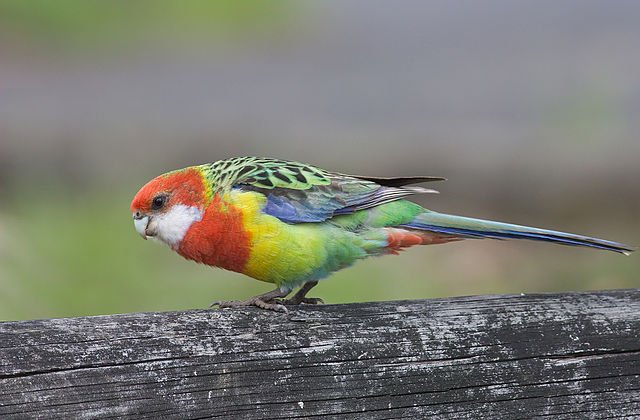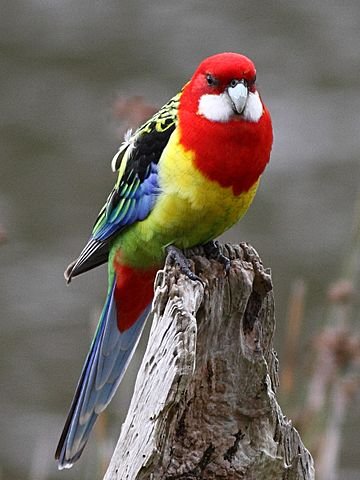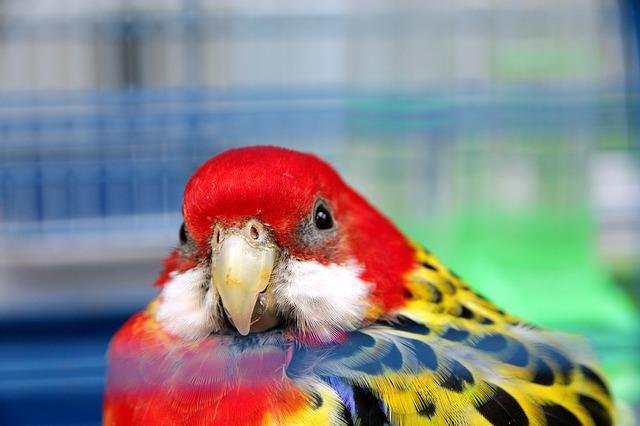The most common Rosellas aka the Eastern Rosellas are one of the most vividly colored parrots across the globe. Though they are adopted lesser than the other parrot species like Budgies or Quaker parrots, there has been an increased demand for them, lately, among the bird lovers and breeders alike.
Despite a rise in their popularity as a pet, not much has been known about their behavior and characteristics as companion parrots. Let us start understanding their behavioral traits right from the beginning, i.e., their living in the wild.
Eastern Rosella Behavior in the Wild
Social
Easterns are flock parrots and prefer to eat and stay together. They are mostly seen in small pairs of 4-5 birds when spotted near the urban settlements. And when in the forests, they can hardly be seen without their flock that comprises around 30 or more birds. This makes them popularly known as social parrot species.
Playful
When in the wild, Easterns can mostly be spotted chirping and playing together. Their playful behavior in the wild has attracted the attention of many breeders that ultimately pitched them as one of the most suitable companion parrot species.
Shy
Being shy is another noticeable behavioral trait of Easterns. Against their other Rosella cousins like Crimsons, they are extremely shy. Where many Rosellas like Crimsons are known to let the people feed them in public parks or gardens, Easterns prefer to fly away even if seen from a comfortable distance.

Eastern Rosella Baby Behavior
Baby Easterns Rosellas behave differently than that from the adult Easterns. The reason being their behavior being impacted by the way they are reared.
Behavior of a parent-reared Eastern Rosella baby
Learning first-hand from his parents while being reared, a parent-reared baby Eastern automatically behaves the way his parents behave. For a week or two after being hatched, he can barely open his eyes and hence couldn’t differentiate between his flock and humans. He takes them all as equals. Staying calm and composed at a human approaching is his natural response until then.
But as he opens his eyes, he starts noticing his parent’s reaction towards the breeders. The parents’ reluctance and fear towards humans grow onto him too. He then learns to differentiate between his flock and human flock and lives with it his whole life. So a parent-reared Eastern Rosella baby might be fearful of humans and might scream or run away the moment humans approach.
Behavior of a hand-fed Eastern Rosella baby
A hand-fed baby Eastern is picked up by the breeder from the aviary the moment he turns 2 or 3 weeks old. By that time, they had hardly established a difference between a bird and a human. A sense of comfort gets developed in them being around human species. They don’t fear humans and their presence anymore for the rest of their lives.
Eastern Rosella Adult Behavior
As life goes on, a living beings’ behavior evolves, An Eastern also becomes a different being as it leaves his infancy days behind. The bird’s behavior is impacted largely by his interaction with another race; humans. He learns to cohabit peacefully and accept them as companions.
This holds for an Eastern Rosella baby too. After having learned to gel well with human species, an Eastern grows into an adult having distinct traits than when parent-reared. He has a playful, social, and entertaining demeanor.
Some days might be depressed and stressful too for the bird due to hormonal changes or bad mood. A combination of all these traits makes up a personality that is different from a wild Eastern.
Playful behavior
An Eastern Rosella has a playful behavior when in captivity. He loves to play around and keep himself and others around him entertained. This behavioral trait of him has recently earned him a lot of attention from the bird lovers and keepers alike.
Affectionate behavior
Easterns form as affectionate companion bird and they love to be a part of their ‘human flock’. Once a close and comfortable bond is developed between the bird and the owner, the bird loves to express his love and affection in various ways. And the most famous way of expression is riding on the shoulders of their human companion wherever they go. This behavior of theirs is accredited for their growing adoption across the globe.
Social behavior
Easterns are famous for being flock birds and this is evident from the fact that wherever they go, they move with their flock only. This inherently makes them a social creature. When in captivity, the behavioral trait flares up and all they want is be interactive and gel with his human flock. They hardly like to be let alone.
Calm Behavior
Being shy in the wild instills a sense of calmness in the species that has become its indispensable part. They generally stay very calm towards the owner. There hardly comes any situation when they shout at or is loud with the owner.
Eastern Rosella Aggressive behavior
Known to be a calm and quiet bird otherwise, Easterns too have their bad days. And most of them fall during their hormonal changes. The breeding season makes an Eastern a bit aggressive. Though the female still stays much calmer, the male Eastern’s aggression can suddenly come across as an alien behavior to the owner.
Quiet behavior
Easterns are known to be a species that isn’t very loud. Apart from an occasional call in the morning or evening, they hardly make any voice that can be considered noise. Due to their calm and quiet behavior, Easterns are considered one of the best pets for an apartment dweller as the voices can barely be heard by the neighbors.
Breeding behavior
Whenever an Eastern likes a mate, he’ll let this know by wagging his tail. Like some other parrot species, an Eastern’s breeding behavior can be known from the love and affection he showers to his mate by mutual feeding. A hen may respond by fluffing her feathers or letting out an occasional call.
Eastern Rosella Talking
Easterns aren’t known for their talking abilities. They lag behind many other parrot species in this talent. They can hardly utter a word or two and that too after a lot of effort and training on the owner’s part. But still, there is one thing they are adept at. And that is whistling. They love whistling and entertaining everyone around with improvised compositions they heard back in the day.
Eastern Rosella Biting behavior
A nip is an act of retaliation of an aggressive or irritated Eastern. Many Easterns show biting behavior if they have a bad mood or are simply irritated with their owner. They express their emotion this way. However, the bird can be trained against the behavior. But that demands a lot of time and patience on the owner’s part.
Eastern Rosella Nesting behavior
At the onset of the breeding season, the Eastern’s nesting behavior is on display. The hen might no longer want the affection and attention of his owner and can crave for a mate. A few Easterns can start making nests at their preferred spots, i.e., inside their cages or in the darkest corners like behind bookshelves, chest drawers, etc. Discourage this behavior, by removing all the dark box-like structures from and around his nest and by restricting his access to other dark corners.
Eastern Rosella Mating behavior
Eastern Rosella, like many other parrot species, mates for life. But for this, they first need to bond well with each other. Once the male is sexually attracted to the female, he expresses his feelings to her. If the female also responds, the birds are ready to take the next step. They show their love to each other by feeding each other. The male will continue feeding the female during her laying and incubation period until the young ones are hatched.
Training an Eastern Rosella for Good Behavior
Being wild parrots and still in the transitional phase of becoming a favored companion pet, training an Eastern Rosella needs special emphasis. The breeders must do this from the very first of the chick by teaching him everything that ultimately lends the bird a lovable personality. An irritable and aggressive bird can never keep himself happy and healthy.
One can use a few techniques that have been proved successful with many breeders as well as owners during the training period. Special treats in the form of nuts, positive reinforcement, or giving him some time out of the cage are a few great techniques.
Wise Words
Like every living being, Easterns also have a few shades to their personality. They can be happy, playful, and energetic. And then they can be aggressive, territorial, and nippy. It all depends on the owner how to train his bird from the beginning. The owner must encourage good behavior and discourage bad acts since the bird’s infancy days. This will make the young bird a pleasing and loving personality for the good of both the bird and, as a bonus, for the owner too.
Read about Eastern Rosella Gender Difference.
https://parrotquaker.com/eastern-rosella-gender-difference/




